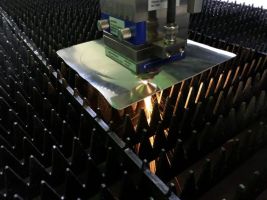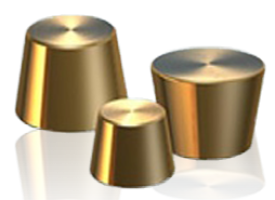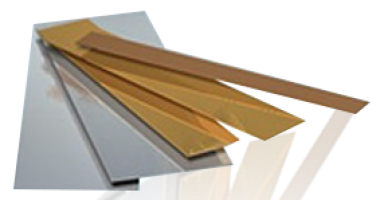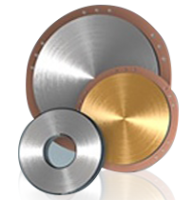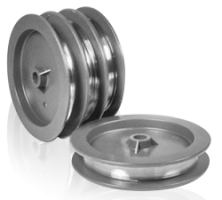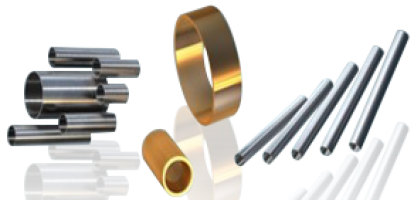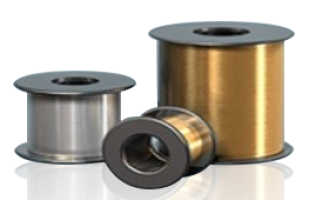Customised Platinum Components
At XRF Scientific, we have decades of experience manufacturing customized platinum components for unique applications. Our state-of-the-art manufacturing facility is based in Melbourne, Australia, and we constantly invest in new technologies to upgrade our capabilities. We can manufacture products using several different alloys from the platinum group metals. Our engineering team will work with you directly to manufacture your product according to your existing drawings, or we can prepare new drawings according to your specifications.
Evaporation Material
Evaporation is a standard method of thin-film deposition. The source material is evaporated in a vacuum, allowing vapor particles to travel directly to the target object (substrate) and condense back to a solid state. Microfabrication uses evaporation to make macro-scale products such as metalized plastic film.
Evaporation involves two fundamental processes: a hot source material evaporates and condenses on the substrate. This process resembles the familiar one by which liquid water appears on the lid of a boiling pot. However, the gaseous environment and heat source (see “Equipment” below) differ.
Evaporation occurs in a vacuum, i.e., vapors other than the source material are almost entirely removed before the process begins. In a high vacuum (with a long mean free path), evaporated particles can travel directly to the deposition target without colliding with the background gas. (By contrast, in the boiling pot example, the water vapor pushes the air out of the pot before it can reach the lid.) At a typical pressure of 10-4 Pa, a 0.4-nm particle has a mean free path of 60 m. Hot objects in the evaporation chamber, such as heating filaments, produce unwanted vapors that limit the quality of the vacuum.
Using a starter source provides a more stable process, resulting in uniform evaporation since the inconsistent topography of slugs is eliminated. This provides a more uniform surface for the beam to sweep. This translates into a more consistent use of power, requiring less adjustment to reach optimal coating rates.
Flat Platinum Wire
Engineered to precise specifications from high-purity special metals, XRF Scientific flat wire goods satisfy extensive application requirements. Our platinum ribbons are rolled from a precision round wire in a quality-controlled manufacturing process, have rounded edges, and are supplied in spools of varying lengths. We also offer tried-and-trusted gold, iridium, palladium, and silver flat wire suppliers.
XRF Scientific: Premium Flat Wires
Flat wire and ribbon are synonymous but differ from application to application. At XRF Scientific, we do not distinguish between the two. We are dedicated to supplying premium flat wires in platinum and other precious metals in strict specifications for exacting application areas.
We source our raw materials from quality-assured suppliers, and we can fabricate precious metal flat wires like platinum ribbons at purities approaching 99.99%. We take precision round wire and put it through one or more passes in a rolling mill to achieve round-edged ribbons no more than 0.01” vast and thicknesses” as low as 0.0” 05”.
We are among the world’s leading suppliers of precious metal ribbons for the broadest application areas. Our platinum ribbons meet medical-grade specifications and are used in precision electronics, while our silver flat wires are routinely used as decorative elements and jewelry.
You can browse the complete list of applications on this page to learn more about the precious metal flat wires and ribbons we can supply.
Foils
We offer a broad range of forms and a variety of metals to meet any challenge.
The precious metal sheet is rolled down from ingots cast and forged using various melting techniques. Vacuum-cast steel rolls are regularly re-grounded to ensure flatness and a consistent surface finish.
Sheets
State-of-the-art rolling equipment, measurement methods, and proven process expertise ensure consistent control of dimensional, purity,y, and hardness characteristics to specified customer requirements. We supply fabric sheets in various precious metal materials, allowing them to be used, including gold, silver, platinum, and iridium. Foil isil readily available in thicknesses down to .01in.
Sputtering Targets
Sputtering uses low heat to create a superior bond between the sputter source (made of the coating material) and the substrate (the surface to be coated). The process creates a uniform thin-film coating on flat and non-flat surfaces. It is primarily used to develop reflective and non-reflective surfaces and enhance corrosion resistance, wear resistance, and electrical capabilities.
The advantages of sputter coating:
Sputter coating offers significant advantages over other methods of coating and plating. Most notably:
• It results in a more durable and uniform coating than plating can achieve.
• In high-vacuum applications, its large target masses necessitate fewer changeovers, making sputter coating a more maintenance-free process.
• The composition of the coating is very close to the composition of the target material.
• Because there is no need for chemicals, sputter coating is more environment-friendly than electroplating.
• It is less costly than other coating methods, such as electroplating.
• Unlike evaporation, which only deposits material from the bottom up, sputtering can also occur from the top down direction, leading to a more uniform coating.
• The deposit film thicknesses can be finely controlled by adjusting the deposition time and other parameters.
Bonded or non-bonded?
Depending on your needs, XRF Scientific can supply bonded or non-bonded targets. Using bonded targets:
• Prevents the warping of target materials.
• Allows for the water-cooling of the target material.
• Allows for fixation to specific vacuum units.
Thermocouple Wire
Based on genuinely collaborative design protocols with quality-assured suppliers and discerning end-users, XRF Scientific offers a range of tried-and-tested thermocouple-grade platinum wires for accurate temperature monitoring across broad temperature regimes.
All our semi-finished precious metal wiring solutions are fully traceable to a single source, enabling us to guarantee high-quality performance from alloy to alloy and across all specifications. This is critical for our platinum thermocouple wires, designed to operate where conventional alloys cannot.
Types of Thermocouple Wires: S, B & R:
Thermocouples are innovative cables composed of two dissimilar metal wires fused at a single junction. These metals' temperature-dependent conductivity/resistivity means that when the sensing end is exposed to heat, it produces a voltage differential that can be used to calculate the temperature. Various types of thermocouple wires are prescribed based on the atmosphere and temperature range of the sensing environment, the most common being type J (iron and constantan) and type K (nickel-chromium and alum) thermocouples.
At XRF Scientific, we engineer high-performance thermocouple-grade platinum wires for type S, R, and B thermocouples. These far outstrip the operating temperature capabilities of standard temperature sensing elements and can often be used bare in oxidizing atmospheres or highly corrosive environments.
Tubes
Precious metal tubing for all alloys uses the same basic process steps. First, the alloy is blended, and induction is melted in a vacuum chamber with an inert atmosphere. Next, the alloy is extruded to an intermediate size via high-pressure and temperature processes. Finally, the rod is fabricated to the final shape using rolling mills and carbide and diamond dies.
Wires and Rods
Built on a strong foundation of metallurgical expertise and put through a rigorous series of quality assurance protocols, XRF Scientific precious metal products are engineered to exceed expectations. All our unique semi-finished goods are derived from a single quality-assured source. XRF Scientific can deliver whether you are looking for gold, silver, or platinum rods or need a specialist wiring solution based on transition metals.
XRF Scientific: High-Quality Rods and Wires:
Committing to a single supply source and stringent QA testing enables us to supply the purest rod and wire grades in specific configurations. Our gold, silver, and platinum rods are delivered in straight formats in lengths up to 6 ft. We can also engineer transition metal alloys, such as iridium-platinum rods, for medical-grade electrodes.
Our precious metal wire production line receives the same attention. Like our gold, silver, and platinum rods, we can offer precious metal wires with purities approaching 99.99%. We can also engineer precision alloys with specific concentration levels to various specifications with skilled metallurgists.

